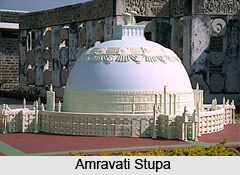 Amaravati which also known as Amrawati or Amraoti is a popular ancient city, which lies on the bank of River Krishna at a distance of 65 kilometres from Vijaywada in Hyderabad, Andhra Pradesh. According to the census of 2001 the population of Amravati was 549,370. The history of Amravati can be traced back to the time of the Mauryan monarch Ashoka who rules from 272 B.C. to 235 B.C. After the decline of the Maurya Empire the later Satvahanas chose Dharanikota near Amravati as their capital. It is also considered one of the famous pilgrimage centers for the Buddhists who worship the Lord Buddha with much veneration.
Amaravati which also known as Amrawati or Amraoti is a popular ancient city, which lies on the bank of River Krishna at a distance of 65 kilometres from Vijaywada in Hyderabad, Andhra Pradesh. According to the census of 2001 the population of Amravati was 549,370. The history of Amravati can be traced back to the time of the Mauryan monarch Ashoka who rules from 272 B.C. to 235 B.C. After the decline of the Maurya Empire the later Satvahanas chose Dharanikota near Amravati as their capital. It is also considered one of the famous pilgrimage centers for the Buddhists who worship the Lord Buddha with much veneration.
Amravati is mainly known for the Buddhist stupas that were built in the area. These stupas indicate the spread of Buddhism in Amravati. Historically an envoy of the Mauryan ruler Ashoka, spread Buddhism in this region that laid the foundation of the Great Stupa at Amravati. With the decline of the Buddhism the stupa at Amravati collapsed and some of its sculptures were buried in the rubble. The re-discovery of the site of Amravati is not very clear. It is however believed that an enterprising zamindar shifted his residence to this place around the year 1796. He invited other people to settle there and this led to the construction of houses and roads in the later ages. The history of Amravati is also associated with the freedom struggle of India. Freedom fighter Bhagat Singh was hiding here during his underground tenure. In the recent times the Archaeological Survey of India has conducted further excavations in this site.
Amravati has been a major city of ancient India. It was under the rule of the Hindu rulers who ruled over the areas of Vijaywada and its surroundings. The area was included as the capital of Andhra satvahanas who ruled in 2nd century BC. This place became a major part of the Andhra Ishvakus and Later Pallava kings who continued to rule in the area after the decline of the satvahanas. As a major city of ancient India this city developed the major trends of Indian sculptures. This was developed into Amravati School of Art that spread its influence in other parts of South India and Sri lanka. Besides this Amravati is also known for the great Shiv Temple that stands at the bank of River Krishna. Known as Lord Amreshwara this temple includes a number of inscriptions that provide information about the rulers who ruled the area. Dedicated to the holy shrine of Amaralingeswara, it is one of the oldest temples of Amravati dedicated to Lord Shiva.
Amravati offers a number of hotels with various tourist packages. The hotels of this city are not only unique in architectural design but are also suited for business and leisure travellers alike. The hotels are known by their diplomacy and offers one all the luxurious comforts to suit the budget. The interiors of the hotels possess unparalleled elegance and grace. Being a prominent spiritual tourist attraction, the city of Amravati in the northern part of India is an amalgamation of different cultures.
Amravati, in present day, is linked by frequent trains to and from the major metros as well as the other destinations of India. The nearest railway stations are Guntur and Vijaywada and the railway network is connected to all the major destinations. The national and state highway network links this town to many important cities in India. All sorts of hired transports are available and all comes with the most experienced drivers. There are good bus connections from Guntur and Amravati. The nearest airport to Amravati is at Vijaywada, which is at a distance of 65 kilometers.
Thus with the Stupas of 2nd century and Hindu temples of 2nd and 3rd century Amravati has been able to attract a large number of tourist who visit the ancient city with a lot of reverence.



















